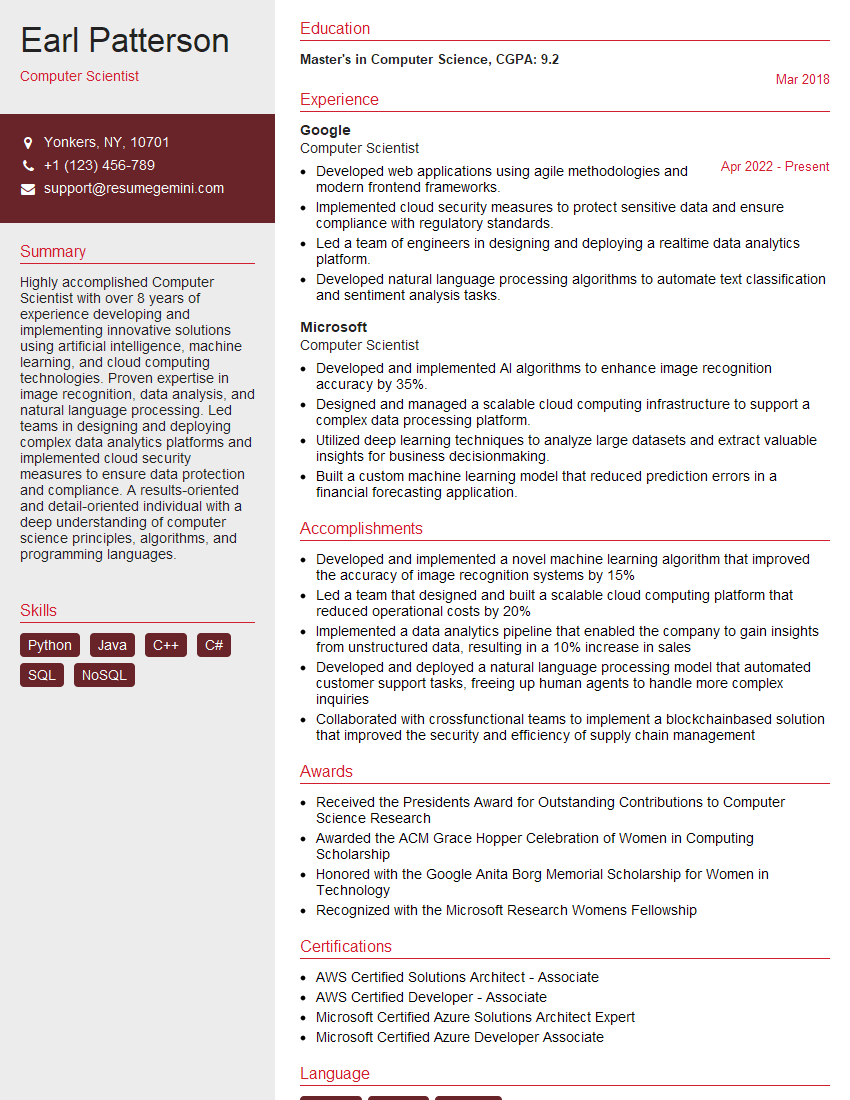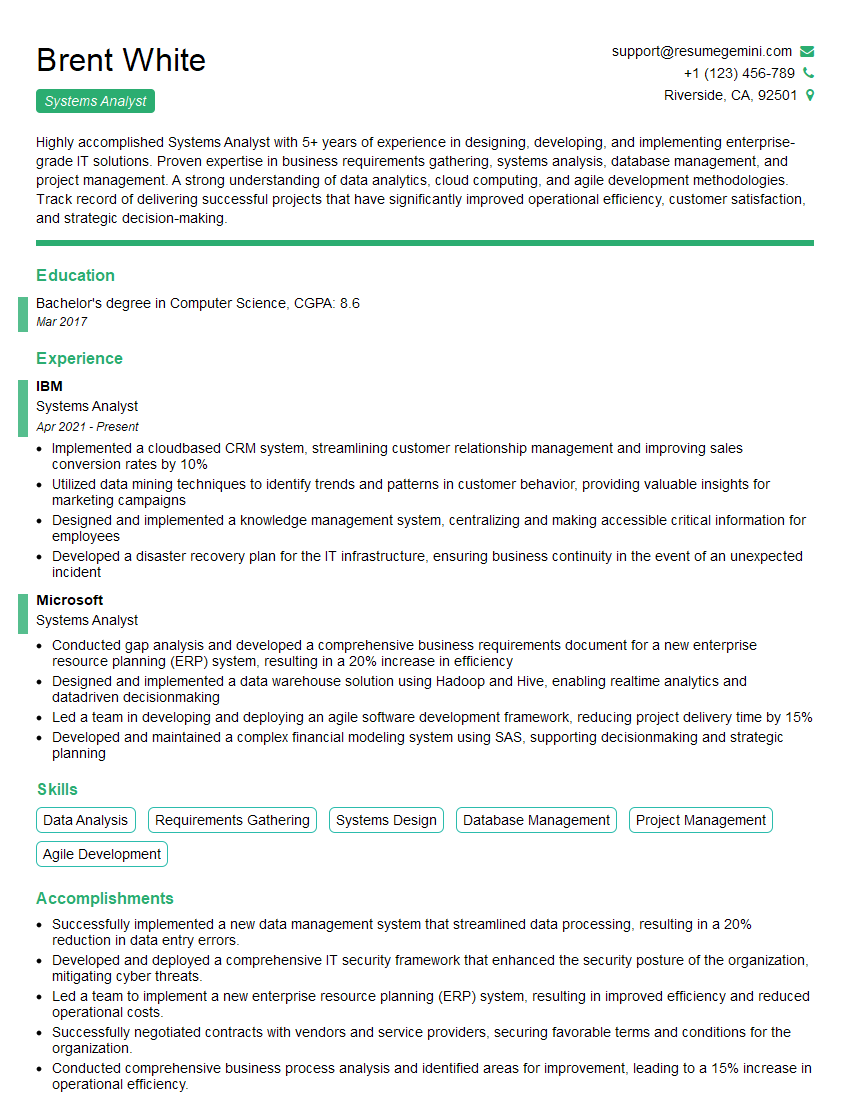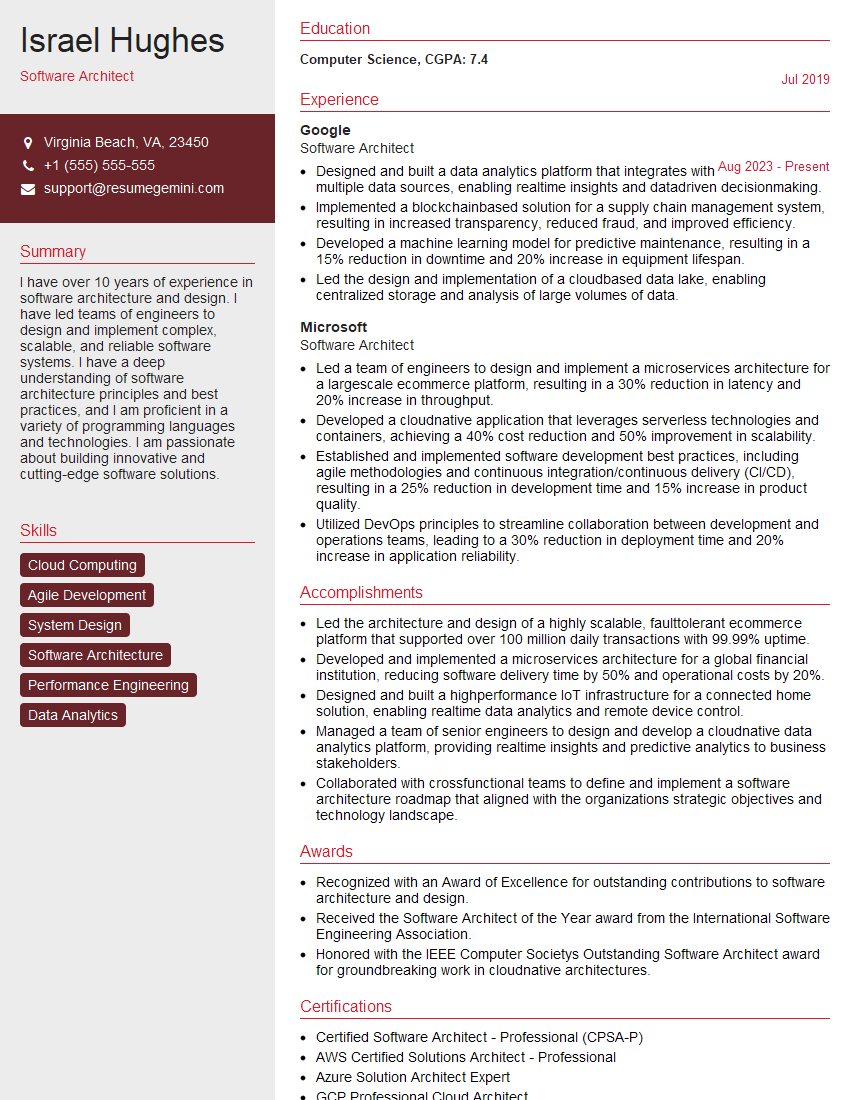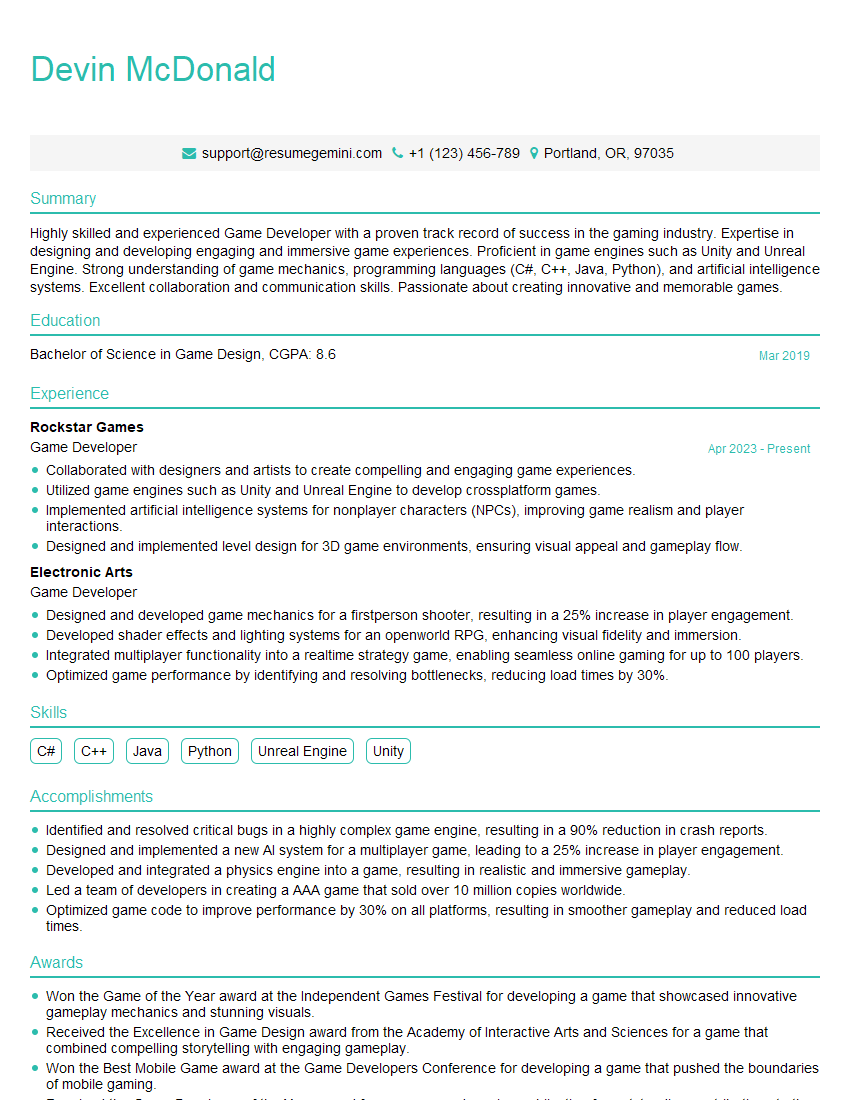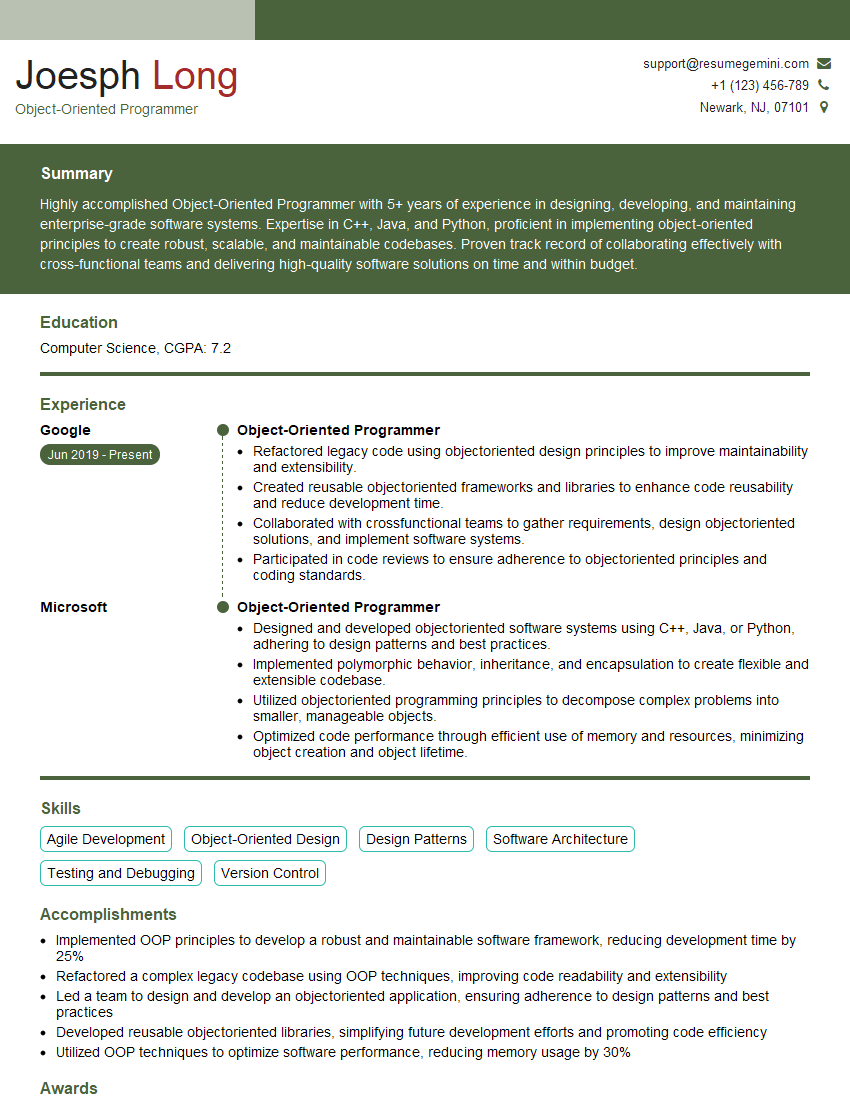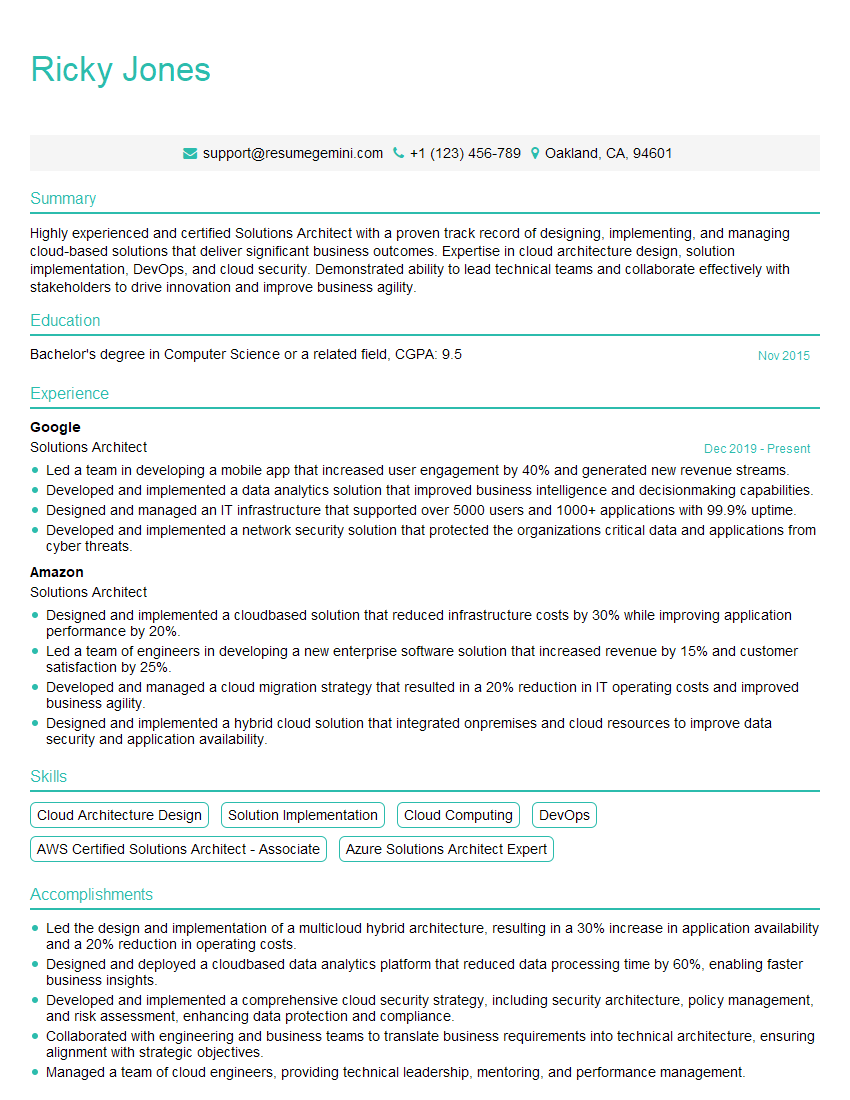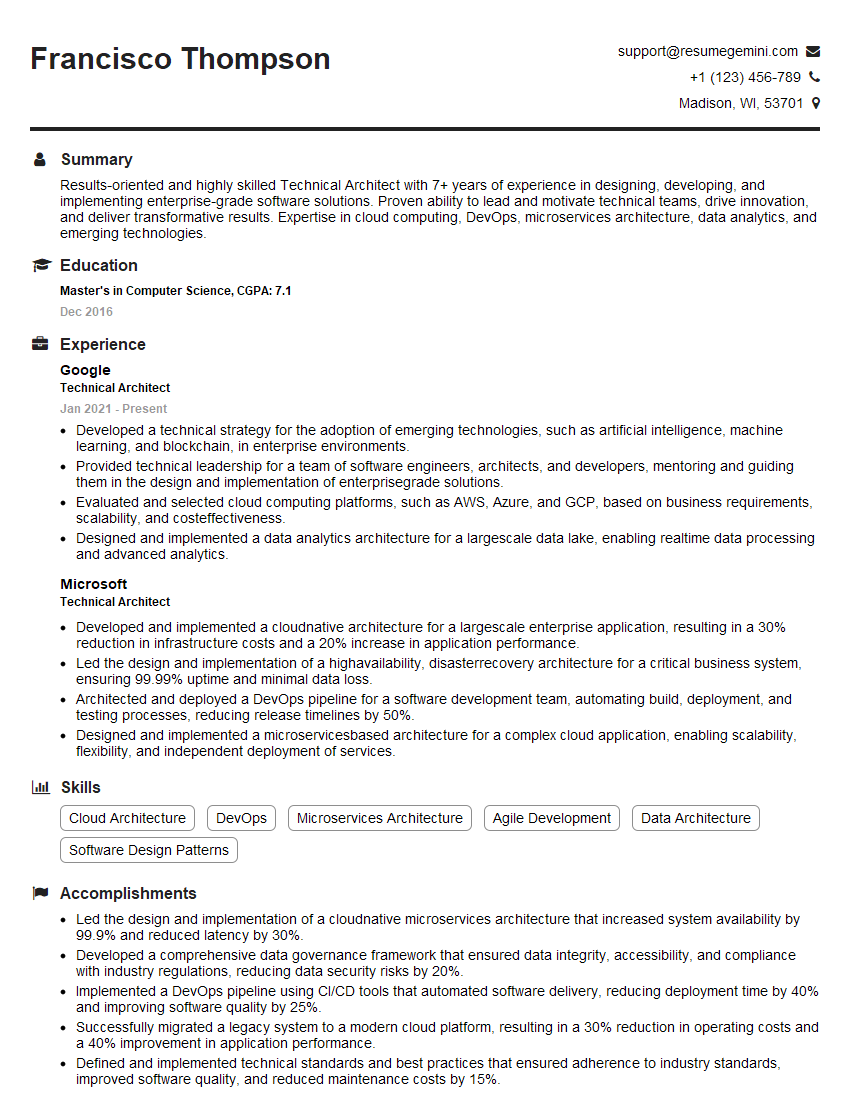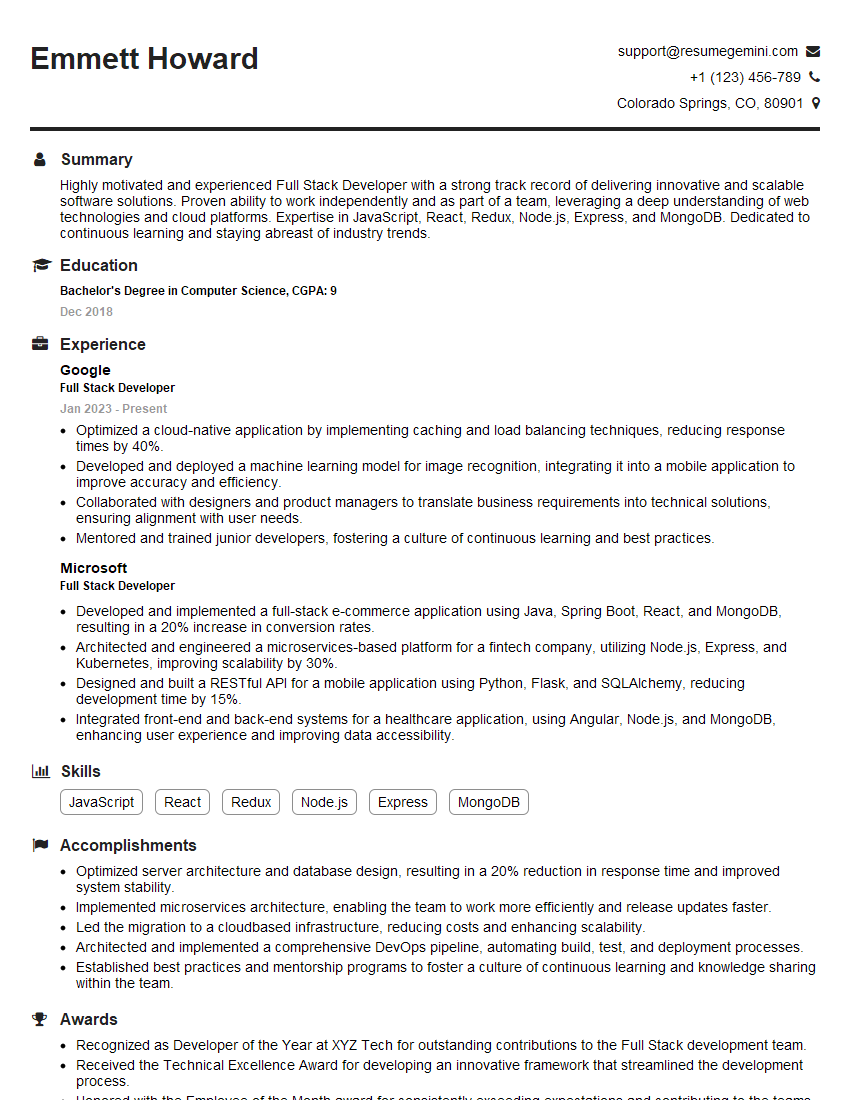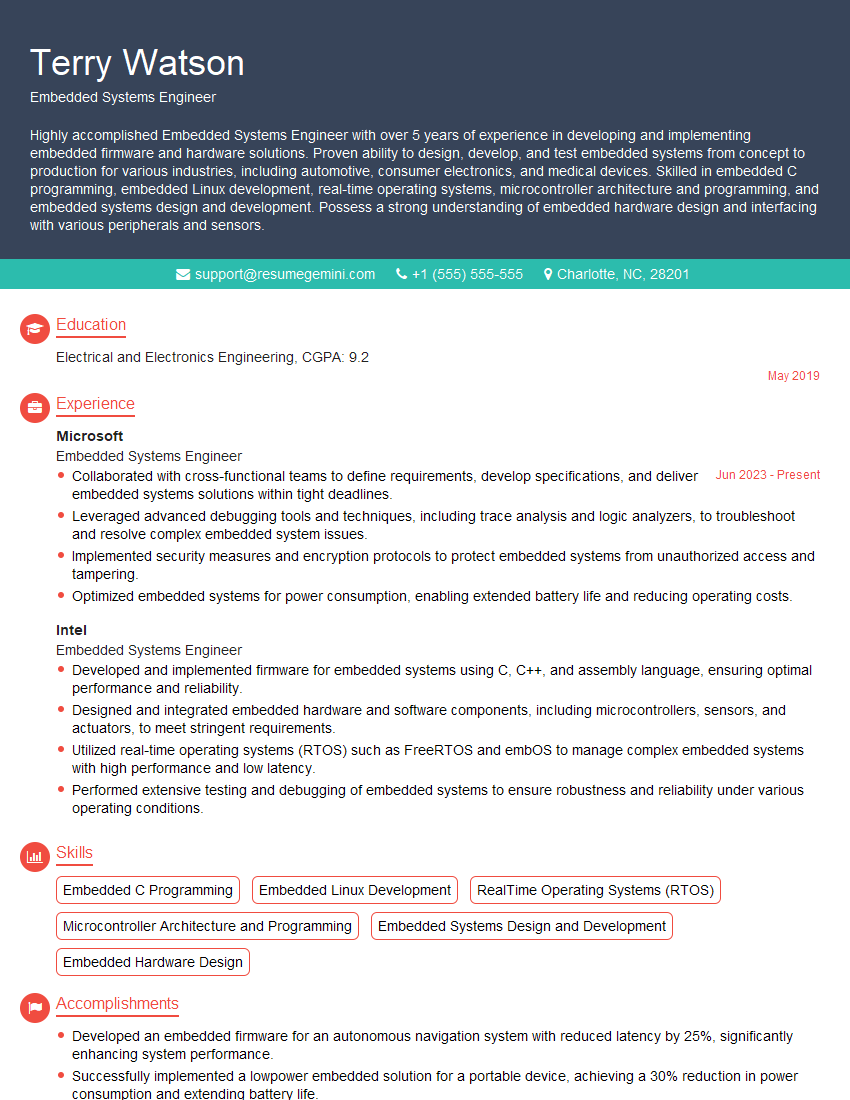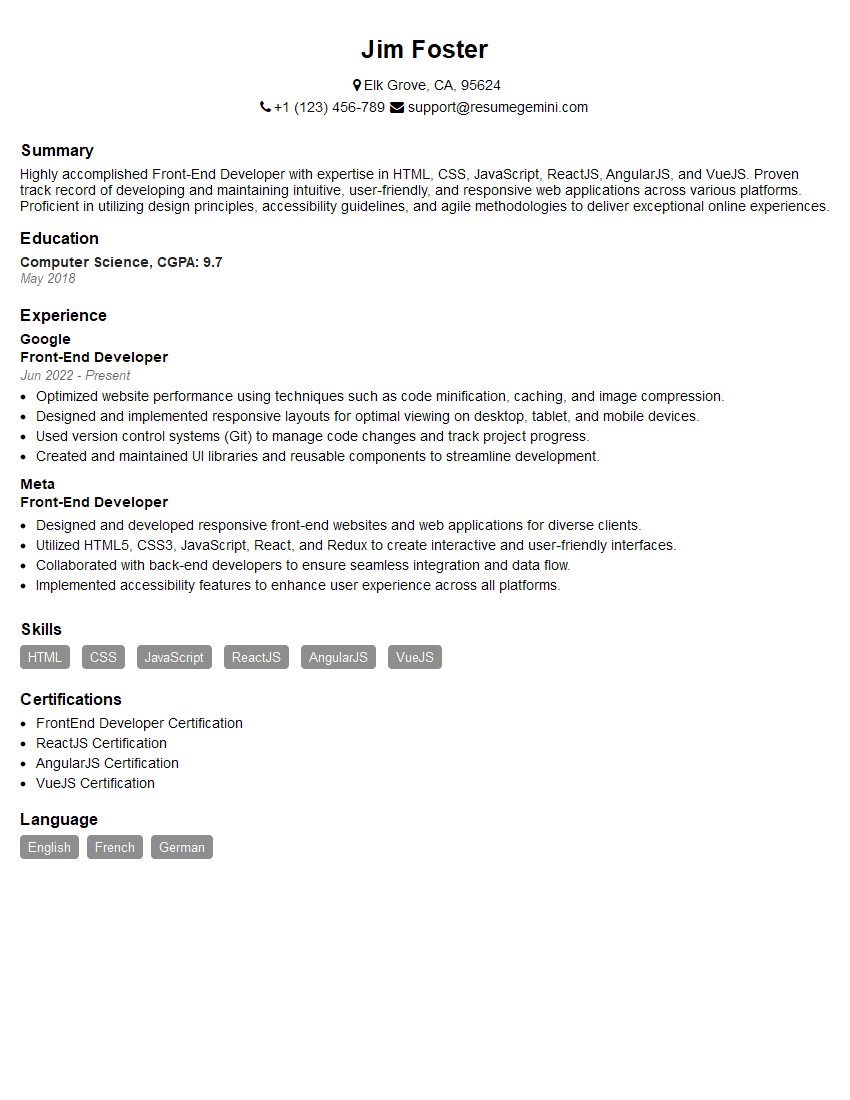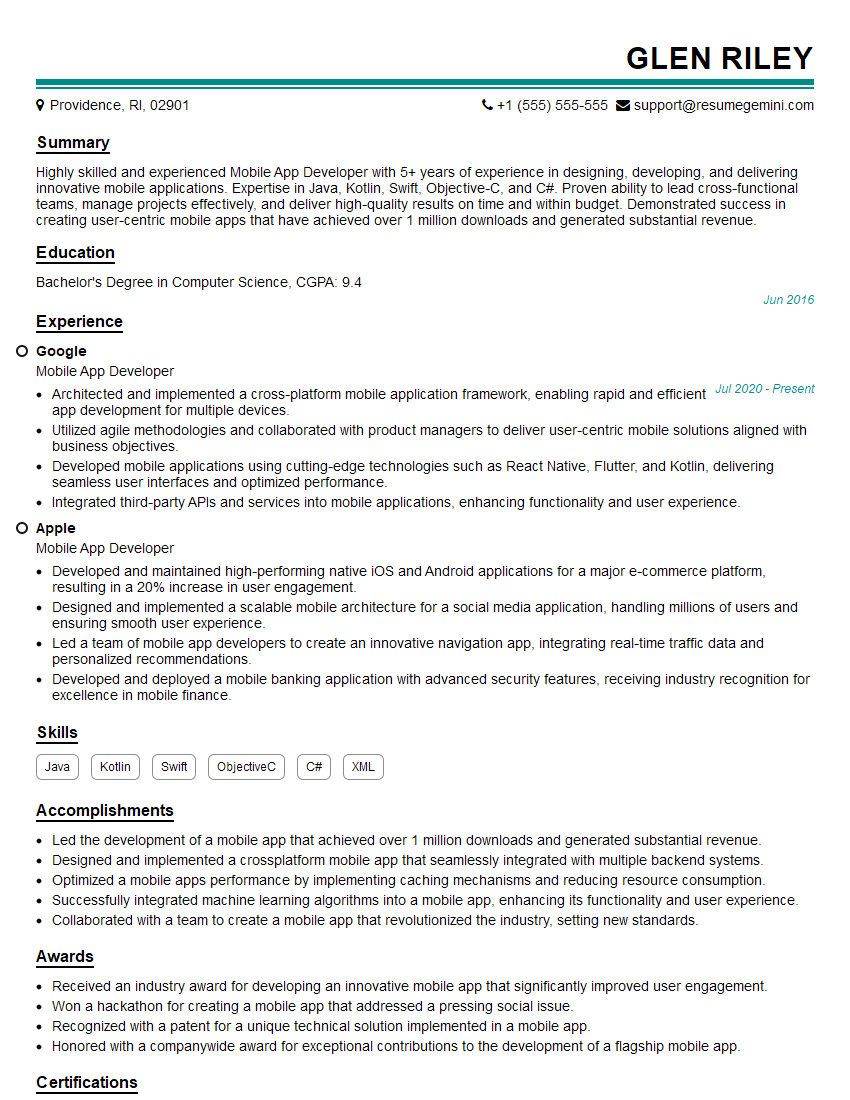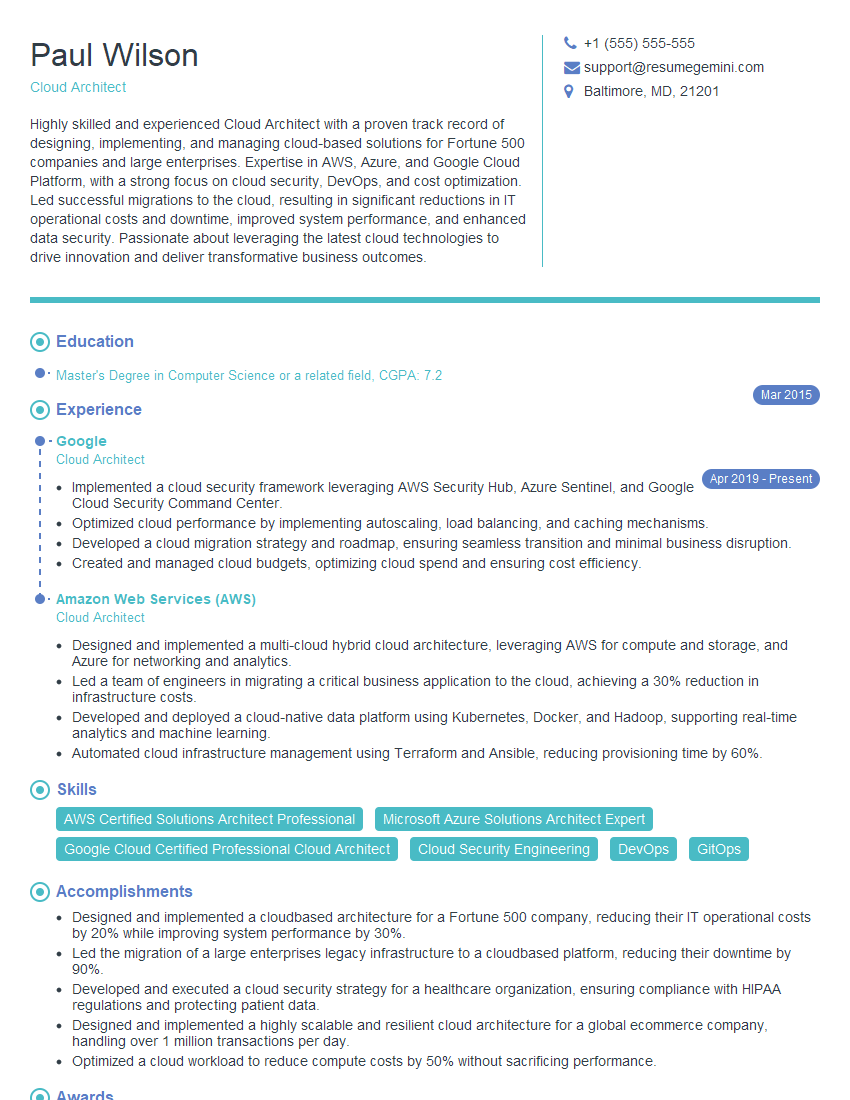Feeling uncertain about what to expect in your upcoming interview? We’ve got you covered! This blog highlights the most important Object Manipulation interview questions and provides actionable advice to help you stand out as the ideal candidate. Let’s pave the way for your success.
Questions Asked in Object Manipulation Interview
Q 1. Explain the concept of encapsulation.
Encapsulation is a fundamental principle in object-oriented programming (OOP) that bundles data (variables) and the methods (functions) that operate on that data within a single unit, a class. Think of it like a capsule containing everything needed for a specific task. This bundling protects the data from accidental or unauthorized access, enhancing security and maintainability.
For example, consider a Car class. It might have data members like model, speed, and fuelLevel. Methods like accelerate(), brake(), and refuel() would manipulate this data. Encapsulation ensures that you can’t directly change the speed variable to an unrealistic value; you must use the provided methods, which can include error checking and validation.
class Car {
private String model;
private int speed;
private double fuelLevel;
public void accelerate() {
//Code to increase speed, with limits
}
public void brake() {
//Code to decrease speed
}
public void refuel(double amount) {
//Code to add fuel, handle overflows
}
}This controlled access improves code organization, reduces the risk of errors, and makes it easier to modify or extend the code without unintended side effects.
Q 2. Describe the four pillars of object-oriented programming.
The four pillars of object-oriented programming are Abstraction, Encapsulation, Inheritance, and Polymorphism. They are design principles that promote code reusability, maintainability, and flexibility.
- Abstraction: Hiding complex implementation details and showing only essential information to the user. Think of a car’s steering wheel; you don’t need to know the intricate mechanics under the hood to drive.
- Encapsulation: Bundling data and methods that operate on that data within a class, protecting it from unauthorized access (explained in the previous answer).
- Inheritance: Creating new classes (child classes) from existing classes (parent classes), inheriting their properties and behaviors. This promotes code reuse and establishes a hierarchical relationship between classes.
- Polymorphism: The ability of an object to take on many forms. This allows you to use objects of different classes through a common interface, simplifying code and increasing flexibility.
Q 3. What is polymorphism and how is it implemented?
Polymorphism, meaning “many forms,” is the ability of an object to take on many forms. It allows you to treat objects of different classes in a uniform way. This is typically implemented through interfaces or inheritance.
Method Overriding: A child class provides a specific implementation for a method that is already defined in its parent class. This allows different classes to respond differently to the same method call.
Method Overloading: A class has multiple methods with the same name but different parameters. The compiler determines which method to call based on the arguments provided.
interface Shape {
double getArea();
}
class Circle implements Shape {
double radius;
//Implementation of getArea() for Circle
}
class Square implements Shape {
double side;
//Implementation of getArea() for Square
}
// ...Using Shape objects uniformly... In this example, both Circle and Square implement the getArea() method differently, yet they are both treated as Shape objects. This avoids lots of conditional statements, simplifying code and enhancing maintainability.
Q 4. What is inheritance and its different types?
Inheritance is a mechanism where one class acquires the properties and methods of another class. The class that inherits is called the child class or subclass, and the class from which it inherits is called the parent class or superclass. It’s like passing down traits from parent to child.
Types of Inheritance:
- Single Inheritance: A class inherits from only one parent class.
- Multiple Inheritance: A class inherits from multiple parent classes (supported by some languages like C++, but not Java, which uses interfaces for a similar effect).
- Multilevel Inheritance: A class inherits from a class, which in turn inherits from another class (forming a hierarchy).
- Hierarchical Inheritance: Multiple classes inherit from a single parent class.
- Hybrid Inheritance: A combination of multiple and multilevel inheritance.
Q 5. Explain the difference between composition and inheritance.
Both composition and inheritance are ways to establish relationships between classes, but they differ significantly in how they achieve this.
Inheritance is a “is-a” relationship. A child class inherits properties and behaviors from the parent class. It represents a specialized version of the parent. Think of a `SportsCar` inheriting from a `Car`.
Composition is a “has-a” relationship. A class contains instances of other classes as its members. This means the class relies on other objects for functionality. A `Car` class might have a `Engine` object as a member.
Key Differences:
- Relationship: Inheritance is “is-a,” composition is “has-a.”
- Tight Coupling: Inheritance creates tighter coupling than composition; changes in the parent class directly affect the child class in inheritance, making it less flexible than composition.
- Flexibility: Composition offers greater flexibility since you can easily switch out the composed objects.
Generally, composition is preferred over inheritance when possible because it results in more flexible and maintainable code.
Q 6. What is abstraction and its benefits?
Abstraction is the process of hiding complex implementation details and showing only essential information to the user. It’s like showing only the necessary buttons on a remote control; you don’t need to know the underlying electronics to use the TV.
Benefits of Abstraction:
- Simplicity: Reduces complexity by hiding unnecessary details.
- Maintainability: Changes in the implementation details do not affect the user interface.
- Flexibility: Allows for easier modification and extension of the system.
- Code Reusability: Abstract classes and interfaces provide a blueprint that can be implemented in multiple contexts.
Example: A user interacts with a `BankAccount` class through methods like `deposit()` and `withdraw()`. The user doesn’t need to know the internal workings of how the transaction is processed – the details are abstracted away.
Q 7. Describe the difference between a class and an object.
A class is a blueprint or template for creating objects. It defines the properties (data) and behaviors (methods) that objects of that class will have. Think of a cookie cutter: the cutter itself is the class.
An object is an instance of a class. It’s a concrete entity created from the class blueprint. It has its own specific data values for the properties defined by the class. Think of the actual cookies you make using the cookie cutter: each cookie is an object.
class Dog {
String breed;
String name;
public void bark() {
System.out.println("Woof!");
}
}
// ... creating objects (instances) of the Dog class ...
Dog myDog = new Dog();
myDog.breed = "Golden Retriever";
myDog.name = "Buddy";
myDog.bark(); In this code, Dog is the class, and myDog is an object (instance) of the Dog class.
Q 8. Explain the concept of method overriding.
Method overriding is a powerful feature in object-oriented programming where a subclass provides a specific implementation for a method that is already defined in its superclass. Think of it like this: you have a general recipe (the superclass method), and a subclass refines it for a specific ingredient or occasion.
The subclass method must have the same name, return type, and parameters as the superclass method. This allows you to maintain a consistent interface while providing customized behavior. It’s crucial for polymorphism, enabling you to treat objects of different classes uniformly while still utilizing their specific functionalities.
Example:
class Animal {
public void makeSound() {
System.out.println("Generic animal sound");
}
}
class Dog extends Animal {
@Override
public void makeSound() {
System.out.println("Woof!");
}
}
public class Main {
public static void main(String[] args) {
Animal genericAnimal = new Animal();
genericAnimal.makeSound(); // Output: Generic animal sound
Animal dog = new Dog();
dog.makeSound(); // Output: Woof!
}
}
In this example, Dog overrides the makeSound() method from Animal, providing a more specific implementation.
Q 9. What is method overloading?
Method overloading, unlike overriding, occurs within the same class. It involves having multiple methods with the same name but different parameters. The compiler distinguishes between these methods based on the number, type, or order of the arguments provided during a method call. It’s like having different versions of a recipe, each tailored to different ingredients or quantities.
Example:
public class Calculator {
public int add(int a, int b) {
return a + b;
}
public double add(double a, double b) {
return a + b;
}
public int add(int a, int b, int c) {
return a + b + c;
}
}
This Calculator class has three overloaded add methods. The compiler chooses the correct method based on the arguments passed. Overloading enhances code readability and reusability by providing a consistent naming scheme for related operations.
Q 10. How do you handle exceptions in object-oriented programming?
Exception handling is crucial for creating robust and reliable object-oriented programs. It’s the mechanism used to gracefully manage runtime errors (exceptions) that might occur during program execution, preventing crashes and ensuring the program continues operating smoothly.
The core of exception handling relies on the try-catch-finally block. You place the code that might throw an exception inside the try block. If an exception occurs, the corresponding catch block handles it. The finally block, optional but recommended, ensures that certain cleanup actions (like closing files or network connections) are performed regardless of whether an exception occurred.
Example (Java):
try {
// Code that might throw an exception
int result = 10 / 0; // ArithmeticException
} catch (ArithmeticException e) {
System.out.println("Error: Division by zero.");
// Handle the exception appropriately
} finally {
System.out.println("This always executes.");
}
Proper exception handling is essential for producing applications that are user-friendly and resilient to unexpected situations. Well-designed exception handling can prevent program termination, log errors effectively, and provide informative messages to users.
Q 11. What are design patterns and why are they important?
Design patterns are reusable solutions to commonly occurring problems in software design. They represent best practices and provide proven templates for structuring code, improving its maintainability, flexibility, and understandability. They are essentially blueprints for solving recurring design challenges.
Think of them as architectural designs for buildings – you wouldn’t design a skyscraper from scratch each time; you’d use established principles and patterns that have proven effective. Similarly, design patterns offer pre-defined solutions you can adapt and apply to your projects, saving time and effort.
The importance of design patterns lies in:
- Improved code quality: Patterns lead to more organized, readable, and maintainable code.
- Reduced development time: By using established solutions, you don’t have to reinvent the wheel.
- Enhanced collaboration: Patterns provide a common language and understanding among developers.
- Increased flexibility and extensibility: Well-designed patterns make it easier to adapt and extend the software.
Q 12. Describe the Singleton design pattern.
The Singleton pattern ensures that a class has only one instance and provides a global point of access to it. It’s like having a single, universally accessible object, such as a database connection or a logger.
The key to implementing a Singleton is to make the constructor private, preventing direct instantiation. You then provide a static method that creates and returns the single instance, ensuring only one is ever created.
Example (Java):
public class Singleton {
private static Singleton instance;
private Singleton() {}
public static Singleton getInstance() {
if (instance == null) {
instance = new Singleton();
}
return instance;
}
}
This example demonstrates the basic Singleton pattern. The getInstance() method handles lazy initialization, creating the instance only when it’s first needed. Thread safety can be a concern in multithreaded environments; consider using double-checked locking or a static initializer for better concurrency control.
Q 13. Explain the Factory design pattern.
The Factory pattern deals with creating objects without specifying their concrete classes. It provides an interface for creating families of related or dependent objects without specifying their concrete classes. Imagine a factory that produces various types of cars—you request a car, and the factory decides which specific car model to produce based on your request, hiding the complexity of the creation process.
This pattern promotes loose coupling, making your code more flexible and maintainable. Changes to the creation process don’t necessarily ripple through the rest of your application.
Example (Java):
interface Shape {
void draw();
}
class Circle implements Shape {
@Override public void draw() { System.out.println("Drawing a circle"); }
}
class Square implements Shape {
@Override public void draw() { System.out.println("Drawing a square"); }
}
class ShapeFactory {
public Shape getShape(String shapeType) {
if (shapeType == null) return null;
if (shapeType.equalsIgnoreCase("CIRCLE")) return new Circle();
else if (shapeType.equalsIgnoreCase("SQUARE")) return new Square();
return null;
}
}
The ShapeFactory creates Circle or Square objects depending on the input. The client code doesn’t need to know the specific object creation process.
Q 14. What is the difference between a static and a non-static method?
The key difference between static and non-static methods lies in their association with objects. Non-static methods, also known as instance methods, are associated with a specific object instance of the class. They can access and modify the object’s state (instance variables). Think of these as methods that work on individual items.
Static methods, on the other hand, belong to the class itself, not any particular object. They can’t access or modify instance variables because they are not tied to an object’s state. They operate independently of any specific object instance. They are like utility functions associated with the class.
Example (Java):
public class MyClass {
int instanceVariable;
public void nonStaticMethod() {
instanceVariable = 10; // Can access instance variable
}
public static void staticMethod() {
//instanceVariable = 20; // Cannot access instance variable
}
}
In this example, nonStaticMethod() can access and modify instanceVariable, while staticMethod() cannot. Static methods are often used for utility functions or factory methods.
Q 15. Explain the concept of garbage collection.
Garbage collection is an automatic memory management feature in many modern programming languages. Instead of the programmer manually allocating and deallocating memory, the garbage collector automatically identifies and reclaims memory occupied by objects that are no longer being used by the program. Think of it like a diligent cleaning crew in a hotel: they identify and clear empty rooms (unused memory) so that new guests (new objects) can be accommodated.
How it works varies by language, but generally involves techniques like reference counting (tracking how many variables point to an object) and mark-and-sweep algorithms (marking reachable objects and reclaiming the rest). The benefits include preventing memory leaks (where programs consume ever-increasing amounts of memory), simplifying memory management for developers, and enhancing program stability.
For instance, in Java, if you create an object and then no longer need it, the garbage collector eventually detects its inaccessibility and frees up the associated memory. This prevents memory exhaustion errors.
Career Expert Tips:
- Ace those interviews! Prepare effectively by reviewing the Top 50 Most Common Interview Questions on ResumeGemini.
- Navigate your job search with confidence! Explore a wide range of Career Tips on ResumeGemini. Learn about common challenges and recommendations to overcome them.
- Craft the perfect resume! Master the Art of Resume Writing with ResumeGemini’s guide. Showcase your unique qualifications and achievements effectively.
- Don’t miss out on holiday savings! Build your dream resume with ResumeGemini’s ATS optimized templates.
Q 16. What are access modifiers (public, private, protected)?
Access modifiers control the visibility and accessibility of class members (fields and methods). They are crucial for encapsulating data and implementing security. The three primary access modifiers are:
public: Members declared aspublicare accessible from anywhere – within the same class, other classes in the same package, or even from different packages.private: Members declared asprivateare only accessible from within the same class. This is the strongest form of encapsulation, hiding internal implementation details.protected: Members declared asprotectedare accessible from within the same class, other classes in the same package, and subclasses (even if those subclasses are in a different package).
Example (Java):
public class MyClass {
private int privateVar;
protected String protectedVar;
public double publicVar;
// ... methods ...
}Here, privateVar is only accessible within MyClass, protectedVar can be accessed by subclasses and classes within the same package, and publicVar is accessible from anywhere.
Q 17. How do you implement data hiding in object-oriented programming?
Data hiding, a core principle of OOP, involves restricting direct access to internal data of an object. This is achieved primarily through access modifiers (private, primarily) and by exposing only controlled access points (methods) to interact with that data. This protects data integrity, prevents unintended modifications, and simplifies the interface for external users of the object.
Example (Java):
public class BankAccount {
private double balance;
public void deposit(double amount) {
balance += amount;
}
public double getBalance() {
return balance;
}
}In this example, the balance is hidden (private). External code cannot directly access or modify it. Instead, it must use the deposit and getBalance methods, which allow controlled interaction, potentially adding validation or logging.
Q 18. What is the difference between an interface and an abstract class?
Both interfaces and abstract classes promote abstraction, but they differ significantly:
- Interface: Defines a contract specifying what methods must be implemented, without providing any implementation details. It can contain only method signatures (no method bodies), constants, and default methods (Java 8 and later). An interface doesn’t have a constructor. A class can implement multiple interfaces.
- Abstract Class: Can contain both abstract methods (with no implementation) and concrete methods (with implementation). It can have instance variables and a constructor. A class can inherit from only one abstract class.
Analogy: An interface is like a blueprint specifying the features of a car (e.g., steering wheel, brakes, engine), while an abstract class is a partial car design with some parts already built (e.g., engine partially assembled) but some parts still needing implementation (e.g., interior).
Q 19. Explain the concept of generics.
Generics allow you to write type-safe code that can work with different data types without losing type information at compile time. Essentially, you define a placeholder type (e.g., T) that can be replaced with a specific type when the code is used. This improves code reusability, reduces casting, and catches type errors at compile time rather than runtime.
Example (Java):
public class MyGenericClass {
private T data;
public MyGenericClass(T data) {
this.data = data;
}
public T getData() {
return data;
}
} In this example, T is a generic type parameter. We can create instances like MyGenericClass or MyGenericClass, and the compiler ensures type safety. This avoids runtime errors associated with incorrect type casting.
Q 20. Describe your experience with different data structures (e.g., linked lists, trees, graphs).
I have extensive experience with various data structures, including:
- Linked Lists: Used extensively in situations requiring frequent insertions and deletions of elements, especially when the insertion or deletion point isn’t known in advance (unlike arrays). I’ve used linked lists in implementing stacks and queues, and in managing dynamically sized data where memory allocation is crucial.
- Trees (Binary Trees, Binary Search Trees, AVL Trees, etc.): Essential for efficient searching, insertion, and deletion operations. For example, I’ve utilized binary search trees in implementing hierarchical data representations and in database indexing systems.
- Graphs (Directed, Undirected): Used extensively in modelling relationships between entities. I’ve applied graphs in scenarios such as social network analysis, route finding algorithms (e.g., Dijkstra’s algorithm), and dependency management.
My experience includes choosing the appropriate data structure based on performance requirements and specific use cases. For instance, the choice between a linked list and an array depends on how often insertions and deletions are performed.
Q 21. How do you choose the appropriate data structure for a given problem?
Choosing the right data structure is crucial for efficient program performance. The selection depends on several factors:
- Frequency of operations: How often will elements be inserted, deleted, searched for, or accessed?
- Order of elements: Does the order of elements matter (sorted vs. unsorted)?
- Access patterns: How are elements accessed (random access vs. sequential access)?
- Memory usage: How much memory is available and how much is required to store the data?
- Implementation complexity: How easy is it to implement and maintain the chosen data structure?
Example: If you need frequent insertions and deletions at arbitrary positions, a linked list is a good choice. If you need fast random access and sorting isn’t crucial, an array might be better. If efficient searching is paramount, a binary search tree or a hash table could be more suitable. The choice always involves a trade-off between different factors.
Q 22. What are the advantages and disadvantages of using objects?
Objects, the fundamental building blocks of object-oriented programming, offer significant advantages but also come with some drawbacks. Think of them like well-organized boxes holding related information and actions.
- Advantages:
- Modularity and Reusability: Objects encapsulate data and methods, promoting code reusability and easier maintenance. Imagine building with LEGO bricks – each brick is an object, and you can combine them in different ways to create complex structures.
- Abstraction: Objects hide internal complexities, presenting a simplified interface to the user. You don’t need to know how a car engine works to drive a car; similarly, you only interact with an object’s public methods.
- Data Integrity: Encapsulation protects data from accidental or unauthorized modification, ensuring data consistency. This is like a sealed container protecting its contents.
- Extensibility: Inheritance and polymorphism allow for easy extension and modification of existing objects without affecting other parts of the system. This is like adding new features to a pre-existing LEGO set.
- Disadvantages:
- Increased Complexity: Designing and implementing object-oriented systems can be more complex than procedural approaches, especially for smaller projects.
- Performance Overhead: The overhead of creating and managing objects can sometimes impact performance, particularly in memory-constrained environments.
- Debugging Challenges: Debugging object-oriented code can be more challenging due to the complexities of interactions between multiple objects.
Q 23. Explain the concept of object serialization.
Object serialization is the process of converting an object’s state into a format that can be stored (e.g., in a file or database) and later reconstructed. Think of it as taking a snapshot of an object’s data and saving it. This is crucial for tasks like persistence, data transfer, and caching.
Common serialization formats include JSON (JavaScript Object Notation), XML (Extensible Markup Language), and binary formats. Each has its own advantages and disadvantages in terms of readability, size, and performance.
// Example of JSON serialization in Pythonimport jsonclass Person: def __init__(self, name, age): self.name = name self.age = ageperson = Person('Alice', 30)person_json = json.dumps(person.__dict__)print(person_json) // Output: {"name": "Alice", "age": 30}The choice of serialization format depends on the specific application requirements. For example, JSON is widely used for web applications due to its human readability and broad support, while binary formats often offer better performance for large datasets.
Q 24. Describe your experience with object-relational mapping (ORM).
Object-Relational Mapping (ORM) is a technique that bridges the gap between object-oriented programming languages and relational databases. It allows you to interact with databases using objects rather than writing raw SQL queries. Imagine having a translator that converts your object-oriented language into database commands.
I’ve extensively used ORMs like Hibernate (Java), Entity Framework (.NET), and SQLAlchemy (Python) in various projects. These tools simplify database interactions, reducing the amount of boilerplate code required. For example, instead of writing complex SQL queries to retrieve data, you can simply use object-oriented methods to access and manipulate data through objects representing database tables.
In a recent project, we used SQLAlchemy to manage a complex database schema for a large-scale e-commerce application. ORM significantly reduced development time and improved code maintainability. The ability to easily map database tables to Python objects and vice-versa streamlined the data access layer, freeing up our team to focus on other aspects of the application.
Q 25. How would you debug an issue related to object manipulation?
Debugging object manipulation issues often requires a systematic approach. Here’s a strategy I usually follow:
- Reproduce the error: First, ensure you can consistently reproduce the issue. This is often the most challenging step.
- Use a debugger: Step through the code line by line, inspecting the state of objects at various points. This helps identify where the error occurs.
- Log object state: Strategically place logging statements to print object properties and method calls. This creates a trace of object interactions, making it easier to identify anomalies.
- Inspect object references: Verify that object references are correct and that objects are not unintentionally shared or mutated.
- Unit tests: Write unit tests to isolate and verify the behavior of individual objects and methods. This helps prevent regressions and catch errors early.
- Memory analysis tools: In cases involving memory leaks or unexpected object behavior, tools like Valgrind (for C/C++) or memory profilers can be invaluable.
For instance, if I encounter a NullPointerException, I would carefully trace back the object references to determine why an object is unexpectedly null. Careful use of logging and the debugger can quickly isolate the root cause.
Q 26. How do you optimize the performance of code involving object manipulation?
Optimizing the performance of code involving object manipulation often involves several strategies:
- Reduce object creation: Avoid creating unnecessary objects, especially within loops. Reuse objects whenever possible. Think of it like reusing plates instead of constantly getting new ones.
- Object pooling: For frequently used objects, consider using an object pool to reduce the overhead of repeated object creation and destruction. This is like having a stack of pre-washed plates readily available.
- Efficient data structures: Choose appropriate data structures based on access patterns. Using a
HashMapinstead of a list for frequent lookups can significantly improve performance. - Caching: Cache frequently accessed objects or results to avoid redundant computations. This is like creating a frequently accessed ingredient ‘station’ in the kitchen.
- Avoid deep copies: Deep copies of objects can be computationally expensive. If possible, use references or shallow copies instead.
- Profile your code: Use profiling tools to identify performance bottlenecks. This allows you to focus optimization efforts on the areas that need them most.
For example, if a loop creates many temporary objects, refactoring it to reuse a single object can significantly reduce the overhead, making your application run faster and smoother. Profiling helps pinpoint exactly where this improvement is needed.
Q 27. Describe your experience with memory management related to objects.
Memory management related to objects is crucial for preventing memory leaks and ensuring application stability. The approach varies depending on the programming language.
In languages with garbage collection (like Java, Python, and C#), the garbage collector automatically reclaims memory occupied by objects that are no longer referenced. However, understanding how garbage collection works is important to avoid issues like premature garbage collection or long garbage collection pauses.
In languages without automatic garbage collection (like C and C++), manual memory management using techniques like smart pointers and reference counting is critical. Improper memory management can lead to memory leaks (unreleased memory) or dangling pointers (pointers to memory that has been freed), causing crashes or unpredictable behavior.
In my experience, I’ve dealt with both scenarios. In Java, I’ve focused on designing efficient data structures to minimize garbage collection pauses in high-performance applications. In C++, I’ve employed smart pointers and thorough testing to ensure the correct management of memory allocated for objects.
Q 28. What are some common pitfalls to avoid when working with objects?
Several common pitfalls to avoid when working with objects include:
- Mutable objects in immutable collections: Adding mutable objects to immutable collections can lead to unexpected behavior if the mutable object’s state changes.
- Ignoring object life cycle: Failing to properly handle object creation, initialization, use, and destruction can lead to resource leaks or unexpected behavior.
- Excessive coupling: Tight coupling between objects can make code brittle and difficult to maintain. Strive for loose coupling.
- Ignoring immutability: Modifying objects intended to be immutable can lead to hard-to-find bugs.
- Improper exception handling: Not properly handling exceptions when working with objects can lead to application crashes.
- Overuse of inheritance: Excessive inheritance can make the code complex and difficult to understand.
By carefully considering object design, lifecycle management, and potential issues, one can avoid these pitfalls and build robust, maintainable, and efficient systems.
Key Topics to Learn for Object Manipulation Interview
- Object Creation and Initialization: Understanding different ways to create objects (constructors, factory methods), and properly initializing object states for predictable behavior. Practical application: Designing efficient and robust object instantiation in a large-scale application.
- Object Properties and Methods: Mastering the use of properties (data) and methods (functions) to define object behavior and encapsulate data. Practical application: Implementing classes with well-defined interfaces and responsibilities in a modular system.
- Object Relationships: Grasping the nuances of relationships between objects (composition, inheritance, aggregation). Practical application: Designing flexible and maintainable object models that reflect real-world relationships.
- Object Lifecycle Management: Understanding object creation, usage, and destruction; managing resources effectively to prevent memory leaks. Practical application: Implementing resource management in applications with long-running processes.
- Object Serialization and Deserialization: Learning how to convert objects into a data format (like JSON) for storage or transmission and reconstructing them later. Practical application: Implementing data persistence and communication between different parts of an application.
- Polymorphism and its Applications: Understanding the concept of polymorphism and how it enables flexibility and extensibility in object-oriented programming. Practical application: Designing systems that can handle diverse object types seamlessly.
- Advanced Concepts (depending on experience level): Explore topics such as design patterns (Singleton, Factory, Observer), SOLID principles, and dependency injection. These will demonstrate a deeper understanding of object manipulation.
Next Steps
Mastering object manipulation is crucial for success in software development, opening doors to exciting opportunities and career advancement. A strong understanding of these concepts is highly valued by employers across various roles. To significantly boost your job prospects, create an ATS-friendly resume that highlights your skills and experience effectively. ResumeGemini is a trusted resource that can help you build a professional and impactful resume. We offer examples of resumes tailored to Object Manipulation expertise to guide you. Invest time in crafting a compelling resume; it’s your first impression on potential employers.
Explore more articles
Users Rating of Our Blogs
Share Your Experience
We value your feedback! Please rate our content and share your thoughts (optional).
What Readers Say About Our Blog
Hello,
We found issues with your domain’s email setup that may be sending your messages to spam or blocking them completely. InboxShield Mini shows you how to fix it in minutes — no tech skills required.
Scan your domain now for details: https://inboxshield-mini.com/
— Adam @ InboxShield Mini
Reply STOP to unsubscribe
Hi, are you owner of interviewgemini.com? What if I told you I could help you find extra time in your schedule, reconnect with leads you didn’t even realize you missed, and bring in more “I want to work with you” conversations, without increasing your ad spend or hiring a full-time employee?
All with a flexible, budget-friendly service that could easily pay for itself. Sounds good?
Would it be nice to jump on a quick 10-minute call so I can show you exactly how we make this work?
Best,
Hapei
Marketing Director
Hey, I know you’re the owner of interviewgemini.com. I’ll be quick.
Fundraising for your business is tough and time-consuming. We make it easier by guaranteeing two private investor meetings each month, for six months. No demos, no pitch events – just direct introductions to active investors matched to your startup.
If youR17;re raising, this could help you build real momentum. Want me to send more info?
Hi, I represent an SEO company that specialises in getting you AI citations and higher rankings on Google. I’d like to offer you a 100% free SEO audit for your website. Would you be interested?
Hi, I represent an SEO company that specialises in getting you AI citations and higher rankings on Google. I’d like to offer you a 100% free SEO audit for your website. Would you be interested?
good
